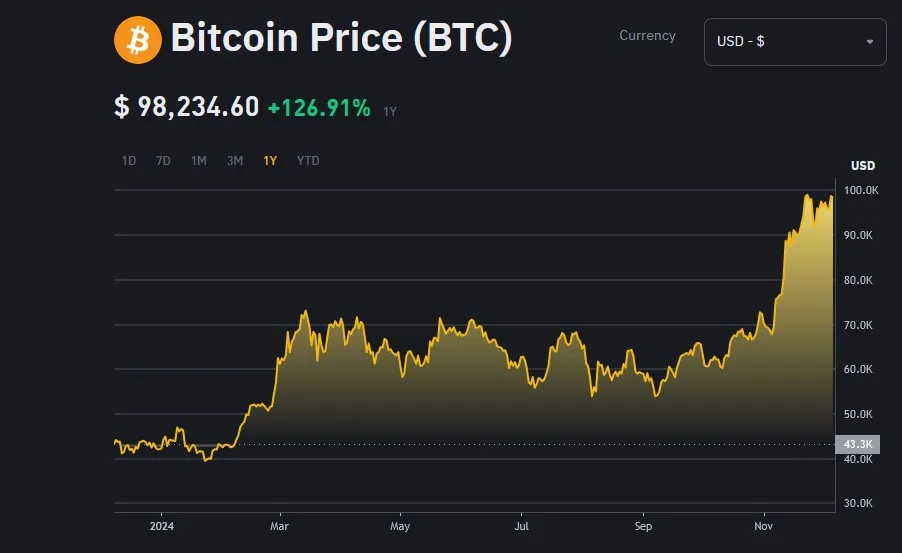
Bitcoin in December 2024: Current Price and Influencing Factors
As of December 6, 2024, Bitcoin (BTC) continues to dominate the global cryptocurrency market. With its robust technology and increasing adoption, Bitcoin remains a key focus for investors worldwide. Let’s take a closer look at its current price and the factors shaping its trajectory.
Bitcoin’s Current Price
Bitcoin is trading at $98,165.00 on Binance, one of the world’s largest cryptocurrency exchanges. Over the past 24 hours, it has seen a decline of 4.596%, with a high of $103,608.00 and a low of $92,839.00. This price behaviour reflects a combination of global market dynamics and crypto-specific developments.
In the past month, Bitcoin’s value surged by an impressive 38.82%, driven by increased institutional interest and market optimism. This growth underscores Bitcoin’s resilience and its ability to attract both retail and institutional investors. Moreover, the cryptocurrency’s liquidity on exchanges like Binance ensures smoother trading operations, even during high market volatility.
The consistent price recovery after market dips highlights the strong demand for Bitcoin. This demand is supported by its limited supply, with approximately 92% of the total 21 million BTC already mined. As mining rewards halve every four years (the next halving is expected in April 2024), scarcity is likely to play a crucial role in driving prices upward.

Key Price Dynamics
Bitcoin’s price is influenced by various factors, ranging from macroeconomic trends to specific developments in the crypto market. The ongoing adoption of Bitcoin ETFs in major markets like the US has attracted substantial inflows of institutional capital, boosting demand.
Additionally, the depreciation of traditional fiat currencies in response to inflationary pressures has led many investors to seek refuge in Bitcoin. The growing narrative of Bitcoin as “digital gold” further cements its position as a hedge against economic uncertainty. At the same time, increasing trading volumes in emerging markets indicate broader acceptance and usage of Bitcoin.
Factors Affecting Bitcoin’s Price
Bitcoin’s value is shaped by a complex interplay of factors, each contributing to its market performance. Understanding these influences can provide deeper insights into the cryptocurrency’s future trajectory.
Institutional Investments
Institutional involvement in Bitcoin has grown significantly over recent years. In 2024, companies like BlackRock and Fidelity have increased their exposure to Bitcoin through ETFs and direct investments. Such moves signal a shift in perception, positioning Bitcoin as a legitimate investment vehicle rather than a speculative asset.
Furthermore, the approval of spot Bitcoin ETFs in the US has opened new doors for institutional investors. This regulatory green light has not only increased capital inflows but also legitimised Bitcoin in the eyes of traditional financial markets. These ETFs provide an accessible way for investors to gain exposure to Bitcoin without directly purchasing or managing the cryptocurrency.
Bitcoin’s increasing integration into financial products is also reshaping its role in the global economy. With central banks experimenting with digital currencies (CBDCs), Bitcoin serves as a benchmark for decentralisation and innovation in the financial system.
Regulatory Developments
The regulatory environment for cryptocurrencies continues to evolve in 2024. In the United States, the SEC’s approval of multiple Bitcoin spot ETFs has provided a clear framework for institutional participation. This regulatory clarity has bolstered investor confidence, leading to increased adoption.
In Europe, the implementation of the Markets in Crypto-Assets (MiCA) regulation has standardised practices for crypto businesses, offering protection for consumers and ensuring market transparency. While these regulations aim to foster innovation, they also mitigate risks associated with fraud and volatility.
Despite these positive developments, some nations have imposed restrictions on cryptocurrency trading and mining. Countries like India and China continue to enforce stringent measures, which can dampen adoption in those regions. However, global sentiment remains predominantly optimistic as governments recognise the economic potential of blockchain technology.
Technological Progress
Technological advancements in Bitcoin’s ecosystem are another significant driver of its price. In 2024, developments in the Lightning Network have enhanced Bitcoin’s scalability, making it more efficient for microtransactions and retail payments. This improvement addresses one of Bitcoin’s long-standing challenges—its slow transaction speeds.
Moreover, the rise of Bitcoin in decentralised finance (DeFi) ecosystems has expanded its use cases. Tokenised versions of Bitcoin, such as wrapped Bitcoin (WBTC), are increasingly being used for lending, borrowing, and liquidity provision in DeFi platforms. This integration broadens Bitcoin’s appeal beyond a store of value or speculative asset.
As blockchain interoperability improves, Bitcoin’s role in cross-chain applications is also growing. These innovations not only enhance Bitcoin’s utility but also increase its demand, positively impacting its market value.
Predictions and Outlook for 2025
Bitcoin’s future prospects appear promising as it continues to integrate deeper into mainstream finance and technology. Analysts forecast that Bitcoin could surpass $120,000 in 2025, driven by increasing adoption, technological innovations, and regulatory clarity.
The upcoming halving event in April 2024 is expected to reduce the mining reward from 6.25 BTC to 3.125 BTC. Historically, such halvings have triggered price rallies due to reduced supply. Many experts believe that this event could serve as a catalyst for Bitcoin’s next significant price surge.
Additionally, the role of Bitcoin in promoting financial inclusion is gaining attention. In regions with unstable currencies or limited banking access, Bitcoin offers an alternative means of conducting transactions and preserving wealth. As adoption in these areas grows, Bitcoin’s relevance in the global financial system is likely to increase.
Future Implications
Bitcoin’s growing adoption across sectors such as retail payments, remittances, and DeFi underscores its versatility. As traditional financial institutions incorporate Bitcoin into their services, its influence on the global economy is set to expand. However, challenges such as environmental concerns and regulatory hurdles need to be addressed to sustain this growth.
In conclusion, Bitcoin remains a resilient and adaptive asset in the cryptocurrency space. Its evolving role as both a store of value and a functional currency ensures its continued significance in the financial landscape of 2024 and beyond.


